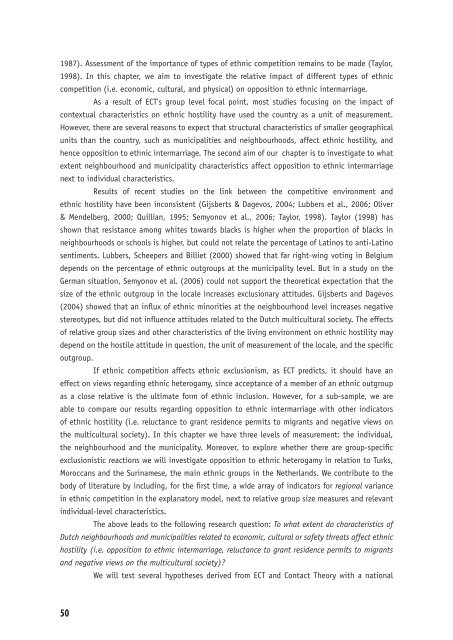Ethnic Hostility among Ethnic Majority and Minority Groups
Ethnic Hostility among Ethnic Majority and Minority Groups
Ethnic Hostility among Ethnic Majority and Minority Groups
You also want an ePaper? Increase the reach of your titles
YUMPU automatically turns print PDFs into web optimized ePapers that Google loves.
1987). Assessment of the importance of types of ethnic competition remains to be made (Taylor,<br />
1998). In this chapter, we aim to investigate the relative impact of different types of ethnic<br />
competition (i.e. economic, cultural, <strong>and</strong> physical) on opposition to ethnic intermarriage.<br />
As a result of ECT’s group level focal point, most studies focusing on the impact of<br />
contextual characteristics on ethnic hostility have used the country as a unit of measurement.<br />
However, there are several reasons to expect that structural characteristics of smaller geographical<br />
units than the country, such as municipalities <strong>and</strong> neighbourhoods, affect ethnic hostility, <strong>and</strong><br />
hence opposition to ethnic intermarriage. The second aim of our chapter is to investigate to what<br />
extent neighbourhood <strong>and</strong> municipality characteristics affect opposition to ethnic intermarriage<br />
next to individual characteristics.<br />
Results of recent studies on the link between the competitive environment <strong>and</strong><br />
ethnic hostility have been inconsistent (Gijsberts & Dagevos, 2004; Lubbers et al., 2006; Oliver<br />
& Mendelberg, 2000; Quillian, 1995; Semyonov et al., 2006; Taylor, 1998). Taylor (1998) has<br />
shown that resistance <strong>among</strong> whites towards blacks is higher when the proportion of blacks in<br />
neighbourhoods or schools is higher, but could not relate the percentage of Latinos to anti-Latino<br />
sentiments. Lubbers, Scheepers <strong>and</strong> Billiet (2000) showed that far right-wing voting in Belgium<br />
depends on the percentage of ethnic outgroups at the municipality level. But in a study on the<br />
German situation, Semyonov et al. (2006) could not support the theoretical expectation that the<br />
size of the ethnic outgroup in the locale increases exclusionary attitudes. Gijsberts <strong>and</strong> Dagevos<br />
(2004) showed that an infl ux of ethnic minorities at the neighbourhood level increases negative<br />
stereotypes, but did not infl uence attitudes related to the Dutch multicultural society. The effects<br />
of relative group sizes <strong>and</strong> other characteristics of the living environment on ethnic hostility may<br />
depend on the hostile attitude in question, the unit of measurement of the locale, <strong>and</strong> the specifi c<br />
outgroup.<br />
If ethnic competition affects ethnic exclusionism, as ECT predicts, it should have an<br />
effect on views regarding ethnic heterogamy, since acceptance of a member of an ethnic outgroup<br />
as a close relative is the ultimate form of ethnic inclusion. However, for a sub-sample, we are<br />
able to compare our results regarding opposition to ethnic intermarriage with other indicators<br />
of ethnic hostility (i.e. reluctance to grant residence permits to migrants <strong>and</strong> negative views on<br />
the multicultural society). In this chapter we have three levels of measurement: the individual,<br />
the neighbourhood <strong>and</strong> the municipality. Moreover, to explore whether there are group-specifi c<br />
exclusionistic reactions we will investigate opposition to ethnic heterogamy in relation to Turks,<br />
Moroccans <strong>and</strong> the Surinamese, the main ethnic groups in the Netherl<strong>and</strong>s. We contribute to the<br />
body of literature by including, for the fi rst time, a wide array of indicators for regional variance<br />
in ethnic competition in the explanatory model, next to relative group size measures <strong>and</strong> relevant<br />
individual-level characteristics.<br />
The above leads to the following research question: To what extent do characteristics of<br />
Dutch neighbourhoods <strong>and</strong> municipalities related to economic, cultural or safety threats affect ethnic<br />
hostility (i.e. opposition to ethnic intermarriage, reluctance to grant residence permits to migrants<br />
<strong>and</strong> negative views on the multicultural society)?<br />
We will test several hypotheses derived from ECT <strong>and</strong> Contact Theory with a national<br />
50












